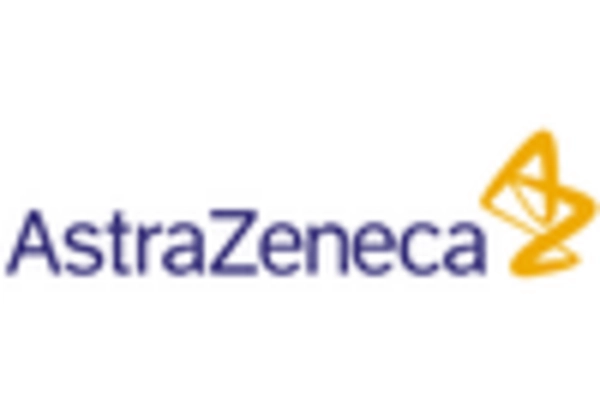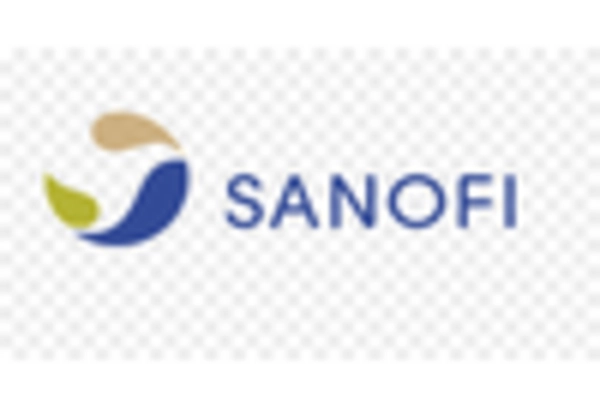Increasing Incidence of DVT
The rising incidence of deep vein thrombosis (DVT) in South America is a critical driver for the deep vein-thrombosis-treatment market. Factors such as an aging population, sedentary lifestyles, and increased prevalence of risk factors like obesity and diabetes contribute to this trend. According to health statistics, DVT affects approximately 1 in 1,000 individuals annually in the region, leading to a growing demand for effective treatment options. This increasing patient population necessitates advancements in treatment modalities, thereby propelling market growth. Furthermore, healthcare systems are likely to allocate more resources towards DVT management, enhancing the overall treatment landscape. As awareness of DVT complications rises, healthcare providers are expected to prioritize early diagnosis and intervention, further stimulating the deep vein-thrombosis-treatment market.
Growing Healthcare Expenditure
The rising healthcare expenditure in South America is a significant driver for the deep vein-thrombosis-treatment market. As countries in the region invest more in healthcare, there is a corresponding increase in the availability of advanced treatment options for DVT. According to recent reports, healthcare spending in South America is projected to grow at a CAGR of 5.5% over the next five years, indicating a robust market environment. This increase in expenditure allows for better healthcare facilities, improved medical technologies, and enhanced training for healthcare professionals. Consequently, patients are likely to receive more effective and timely treatments for DVT, thereby driving demand within the deep vein-thrombosis-treatment market. The focus on improving healthcare quality is expected to create a favorable landscape for market growth.
Advancements in Medical Technology
Technological innovations play a pivotal role in shaping the deep vein-thrombosis-treatment market in South America. The introduction of minimally invasive procedures, such as catheter-directed thrombolysis and mechanical thrombectomy, has revolutionized treatment approaches. These advancements not only improve patient outcomes but also reduce recovery times, making them more appealing to both patients and healthcare providers. The market is witnessing a surge in the adoption of advanced imaging techniques, such as ultrasound and MRI, which enhance diagnostic accuracy. Moreover, the integration of artificial intelligence in treatment planning and monitoring is expected to further optimize patient care. As these technologies become more accessible, the deep vein-thrombosis-treatment market is likely to experience significant growth, driven by the demand for innovative and effective treatment solutions.
Government Initiatives and Funding
Government initiatives aimed at improving healthcare infrastructure and funding for DVT research are crucial drivers for the deep vein-thrombosis-treatment market in South America. Various countries in the region are implementing policies to enhance healthcare access and quality, which includes the management of chronic conditions like DVT. Increased funding for public health campaigns and research initiatives is expected to raise awareness about DVT and its treatment options. For instance, national health programs are likely to allocate budgets specifically for DVT prevention and management, thereby fostering a supportive environment for the market. This proactive approach by governments can lead to improved treatment accessibility and affordability, ultimately benefiting the deep vein-thrombosis-treatment market.
Rising Demand for Preventive Healthcare
The growing emphasis on preventive healthcare in South America is emerging as a vital driver for the deep vein-thrombosis-treatment market. As awareness of DVT risk factors increases, individuals are more inclined to seek preventive measures, such as lifestyle modifications and regular health screenings. This shift towards prevention is likely to result in earlier detection and treatment of DVT, ultimately reducing the incidence of severe complications. Healthcare providers are also focusing on educating patients about the importance of prevention, which may lead to increased utilization of prophylactic treatments. The proactive approach to healthcare is expected to enhance the overall treatment landscape, thereby positively impacting the deep vein-thrombosis-treatment market. As preventive strategies gain traction, the market may witness a transformation in how DVT is managed.


















Leave a Comment